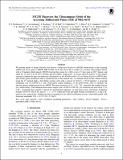NICER Discovers the Ultracompact Orbit of the Accreting Millisecond Pulsar IGR J17062–6143
Author(s)
Strohmayer, T. E.; Arzoumanian, Z.; Bogdanov, S.; Bult, P. M.; Enoto, T.; Gendreau, K. C.; Guillot, S.; Harding, A. K.; Ho, W. C. G.; Homan, J.; Jaisawal, G. K.; Keek, L.; Kerr, M.; Mahmoodifar, S.; Markwardt, C. B.; Ransom, S. M.; Ray, P. S.; Wolff, M. T.; Chakrabarty, Deepto; Remillard, Ronald A; ... Show more Show less
DownloadStrohmayer_2018_ApJL_858_L13.pdf (893.9Kb)
PUBLISHER_POLICY
Publisher Policy
Article is made available in accordance with the publisher's policy and may be subject to US copyright law. Please refer to the publisher's site for terms of use.
Terms of use
Metadata
Show full item recordAbstract
We present results of recent Neutron Star Interior Composition Explorer (NICER) observations of the accreting millisecond X-ray pulsar (AMXP) IGR J17062-6143 that show that it resides in a circular, ultracompact binary with a 38-minute orbital period. NICER observed the source for ≈26 ks over a 5.3-day span in 2017 August, and again for 14 and 11 ks in 2017 October and November, respectively. A power spectral analysis of the August exposure confirms the previous detection of pulsations at 163.656 Hz in Rossi X-ray Timing Explorer (RXTE) data, and reveals phase modulation due to orbital motion of the neutron star. A coherent search for the orbital solution using the Z[superscript 2] method finds a best-fitting circular orbit with a period of 2278.21 s (37.97 minutes), a projected semimajor axis of 0.00390 lt-s, and a barycentric pulsar frequency of 163.6561105 Hz. This is currently the shortest known orbital period for an AMXP. The mass function is 9.12 × 10[superscript -8] M[subscript ⊙], presently the smallest known for a stellar binary. The minimum donor mass ranges from ≈0.005 to 0.007 M[subscript ⊙] for a neutron star mass from 1.2 to 2 M o. Assuming mass transfer is driven by gravitational radiation, we find donor mass and binary inclination bounds of 0.0175-0.0155 M[superscript ⊙]and 19° < i < 27.°5, where the lower and upper bounds correspond to 1.4 and 2 M[subscript ⊙] neutron stars, respectively. Folding the data accounting for the orbital modulation reveals a sinusoidal profile with fractional amplitude 2.04 ±0.11% (0.3-3.2 keV).
Date issued
2018-05Department
Massachusetts Institute of Technology. Department of Physics; MIT Kavli Institute for Astrophysics and Space ResearchJournal
The Astrophysical Journal
Publisher
American Astronomical Society
Citation
Strohmayer, T. E., Z. Arzoumanian, S. Bogdanov, P. M. Bult, D. Chakrabarty, T. Enoto, K. C. Gendreau, et al. “NICER Discovers the Ultracompact Orbit of the Accreting Millisecond Pulsar IGR J17062–6143.” The Astrophysical Journal 858, no. 2 (May 9, 2018): L13. © 2018 The American Astronomical Society
Version: Final published version
ISSN
2041-8213